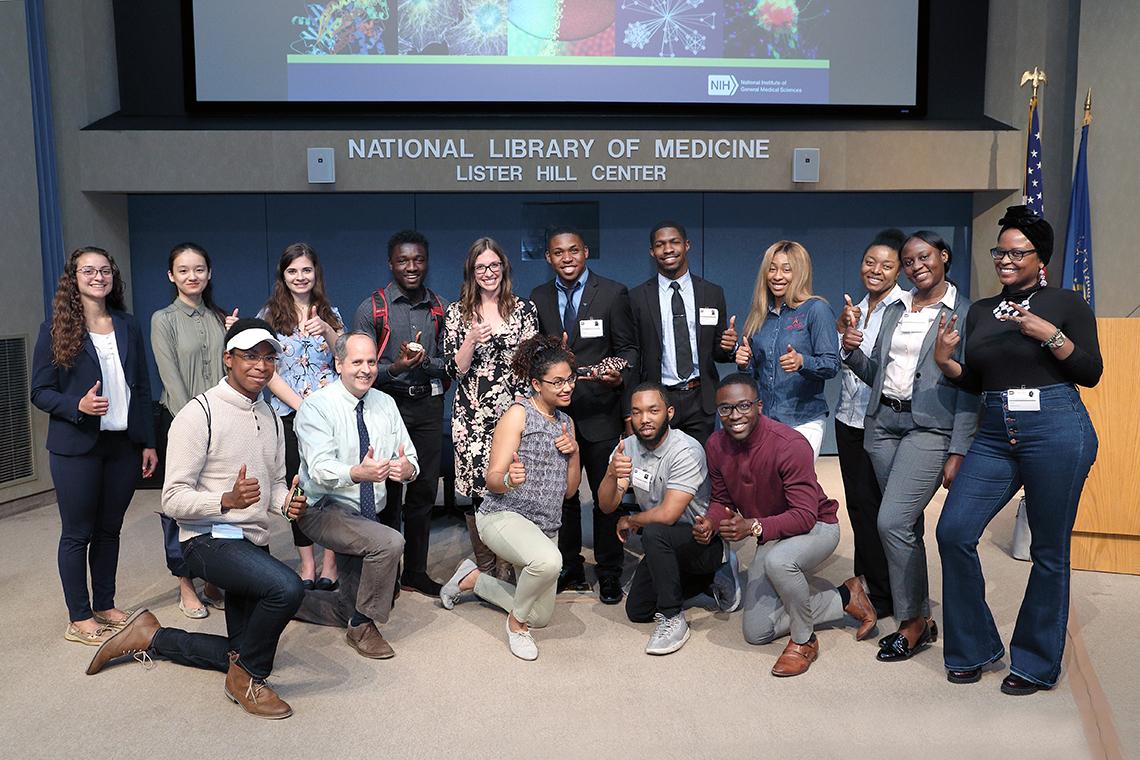Sex Chromosomes Can Trade DNA in Two Regions

Photo: Chia-Chi Charlie Chang
The X and Y chromosomes, also known as sex chromosomes, differ greatly from each other. But in two regions, they are practically identical, said Dr. Melissa Wilson, assistant professor of genomics, evolution and bioinformatics at Arizona State University.
“We’re interested in studying how the process of evolution shaped the X and the Y chromosome in gene content and expression and how that subsequently affects literally everything else that comes with being a human,” she said at the Apr. 10 NIGMS Director’s Early-Career Investigator Lecture in Lister Hill Auditorium, Bldg. 38A.
In humans, each cell contains 23 pairs of chromosomes, for a total of 46. The first 22 pairs look the same in both males and females. The last pair, the sex chromosomes, differ. Typically, females have two X chromosomes, while males have one X and one Y chromosome.
“I say typically because I don’t know which one of us is normal and I don’t like saying something is normal,” she said. “Variations in the sex chromosomes can be pretty typical.”
Historically, most clinical research was conducted in men, she noted. “We’re finding out that treatments designed for men don’t work so well in women.” There is, however, a massive sex difference.
The sex chromosomes have been evolving over the past 200 million years, she explained. At first, the chromosomes were identical. Over time, the Y chromosome started to break and rearrange itself. These inversions made it more difficult to recombine with the X chromosome. Now, the X chromosome has about 1,100 genes while the Y chromosome has just 27 unique genes.
And yet, there are two regions called pseudoautosomal regions (PAR1 and PAR2) on the tips of the sex chromosomes that can pair with each other and swap DNA. This is called recombination. Wilson says a sex-determining gene called SRY sits near the boundary of the regions on the Y chromosome. Individuals who inherited the Y chromosome “went on to make testes, and those who didn’t made eggs.” In some cases, SRY can transfer to the X chromosome.

Photo: Chia-Chi Charlie Chang
A deficiency in PAR1 recombination has been linked to Klinefelter syndrome, a genetic condition where males are born with an extra X chromosome. This occurs in about 1 out of every 500 births in the U.S.
There are other sex-linked disorders besides Klinefelter syndrome. One, called Turner syndrome, happens in about 1 in 2,000 or 2,500 females. Those born with the condition have one missing or structurally altered X chromosome. Another is De la Chapelle syndrome, a rare disorder in which individuals have two X chromosomes, but have a male appearance.
Wilson said the field needs to develop new methodologies to analyze the sex chromosomes, recognizing the complications and appreciating the variations.
Wilson’s lab is also studying the Gila monster’s genome. A black-and-orange lizard native to the southwestern United States and Mexico, Gila monsters have venomous saliva. There’s a peptide in the venom that’s used to treat type 2 diabetes.
“We’d like to understand what the peptide is doing in the monsters and then can better understand how it works in humans,” Wilson said.
Her lecture was followed by a Q&A chat with NIGMS director Dr. Jon Lorsch.

Photo: Chia-Chi Charlie Chang
Wilson asserted, “You’re not going to be able to do biology without understanding programming in the future,” adding that scientists don’t have to be expert programmers, but they must understand it.
She credited her scientific success to diligence, good luck and mentors who made sure she had opportunities and built her confidence.
In her lab, Wilson talks about the challenges of research with her students. It’s important for them to hear different perspectives and realize that “we’re here because we don’t know the answer yet” and that being wrong can still lead to interesting data.
Recently, Wilson was interviewed by Pathways student magazine, a collaboration between NIGMS and Scholastic, Inc. She called the experience “the coolest thing ever” to get to “be in Scholastic.”
